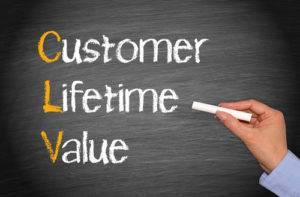Lifetime Value
Congratulations! The first order finally arrived. You’ve been trying to win that client for so long. Everyone’s feeling great-because you also know you can fill the order! Things couldn’t be better…
…until the new customer calls to complain. You’re two weeks into the assignment, and the customer wants a replacement and full credit for the work done. What do you do? Issue the credit? Tell the customer he’s exceeded your service guarantee? Pray he’ll change his mind?
Undoubtedly, your answer depends on many factors. But none matter more than this: how much is that customer really worth to you?
When Stew Leonard, owner of Stew Leonard’s dairy, faced this very same issue, he developed a very novel way to make his decision. As the story goes, a customer returned a carton of eggnog saying that it was spoiled (which it obviously wasn’t). In the grocery business, margins are razor thin, so free replacement policies can be a serious risk.
However, before reacting rashly, Stew did a little math. He determined that the average person in his store was shopping for a family of four, and their weekly grocery bill was around $200.
Maximizing Customers
Multiply that by 50 (allow for vacation), and a customer is worth $10,000 per year. Stew figured that with great service, he could keep a customer for around 20 years.
In other words, each of his customers is worth $200,000! And every five people who walk through his doors are worth a million! What Stew recognized was that every customer represents incredible potential. He learned to appreciate the lifetime value of a customer-long before it became popular to do so.
Why is lifetime value so critical? The obvious answer is the total revenue. Just think about the cost of losing a customer…
The less obvious answer is that lifetime value helps guide decision making. For example, say you are servicing a client and have a dispute about an invoice. Even though you may be right, what will you gain by winning? After all, a $100 or even $1,000 loss today may be trivial compared to the total value of the customer. (Of course, there are those customers who always complain and cause problems. The lifetime cost of servicing these trouble makers often outweighs the value!)
By the way, now when a customer returns a bad carton of eggnog, Stew Leonard not only replaces it, but also gives the customer a second carton for their trouble!
10 secrets to keeping customers
- Deepen relationships
Nurture your customers; focus on building emotional bonds. Make relationships personal, so customers have a hard time letting go. - Broaden relationships
Network within your client’s company; limit your dependence on single points of contact. - Outrageous service
Blow customers away with your attention to detail. Truly exceed expectations. - Consistency
Demand a high level of performance in all aspects of your service. Develop procedures to ensure it’s consistently delivered. Turn every process into a checklist and inspect regularly. - Limit staff turnover
People like to deal with the same people; turnover (especially in your service department) makes clients nervous and often leads to attrition. - Customer intelligence
Know more about your customers business than they do (be a consultant not just a supplier). Anticipate their needs, and help them realize their objectives. - Your corporate culture
Having the right attitude throughout your organization is critical. Reward excellent service and great attitudes. Quickly address and resolve problems. - Flexibility
Empower front-line personnel so they can quickly accommodate customer requirements. But, don’t abandon them! Give them lots of training and coaching. - Reactivity
How quickly can you react to customer needs and opportunities? Practice your reaction skills through training exercises-develop scenarios and plan your reactions. - Combat indifference
According to a recent study, the biggest cause of customer defection is indifference-when customers don’t think you care. Make sure you never create this perception by going to great lengths to constantly remind customers just how important they are to you. - Mistake recovery programs
Mistakes will happen. How you deal with them determines if you keep or lose clients. Create a process to handle problems quickly and efficiently. Go beyond what the customer was expecting (give them the second quart of eggnog!).
(OK that’s 11, but at BARQAR we always want to deliver a little something extra!)
5 Ways to Maximize Customer Value
- Customer share – focus on getting 10 orders out of 10 instead of 5 out of 10.
- Product line extension – add products and services that fit customers’ changing needs (make sure they’re compatible with your ability to deliver).
- Strategic partnering – to satisfy needs you can’t fulfill, find a competent partner.
- Education – teach customers how to better use your services to make their businesses more successful.
- Leverage – get referrals within the company to other departments and to other companies.
Calculating Lifetime Value
The easiest estimate of lifetime value is simply to determine the value of an average customer and then multiply by the anticipated length of service. But first, you have to know what an “average” customer is. To determine the size of an average customer, simply divide your total year-end gross profit (sales less cost of temporary employees and payroll taxes) by the total number of clients you serviced during the year.
To determine the lifetime value, multiply the average customer value times your estimate of how long you retain customers.
An example:
2015
Sales
Temporary wages and taxes
Gross Margin
Number of Clients Served
Average Customer Value (annual)
Length of retention (years)
Lifetime value of average client
$8,000,000
$2,000,000
÷ 500
$4,000
x 10
$40,000
A Final Note About Lifetime Value
Marketers say it costs six times more to win a new client than it does to keep an existing one. What they fail to mention is the cost of losing a customer. If you’re not spending a significant portion of your sales and marketing budget on customer retention, you may want to reconsider. According to a study done by the Harvard Business School Press, in the service industry, improving customer retention by just 5% resulted in more than a 70% increase in profit!
So, the next time a client asks for a special favor, will you give it to them?
Contact BARQAR today and we’ll work with you to develop strategies and tactics that will keep your customer around and increase that Lifetime Value figure!




